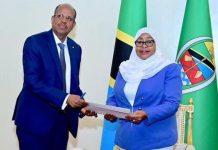Africa-Press – Tanzania. EXECUTION of the Productive Social Safety Net (PSSN) by the Tanzania Social Action Fund (TASAF) has recorded massive success in uplifting living standards of the poorest families, a move that has seen 1,992 households exit from the programme voluntarily.
Also, some 158,000 other beneficiary households are ready to withdraw from the programme, as their living standards have been uplifted after investing and acquired assets for their living through TASAF support.
Speaking yesterday during an event to launch a report of the midline survey that was done to evaluate implementation of the PSSN between 2013 and 2019, TASAF Executive Director, Mr Ladislaus Mwamanga said the programme enabled poorest households to establish small businesses and other economic activities.
According to him, execution of the programme brought positive progress in education, health and economic status to families of the beneficiaries.
“In the education sector we have seen an increased number of children from poor families performing their national examinations and join upper stages of academic levels,” he said.
Mr Mwamanga noted that the findings of the midline survey valuation has it that in the year 2019, a total of 277 children from poor families passed their form six examinations and were enrolled to various universities for higher education.
According to him, many others passed their standard seven and form four examinations and qualified to join form one and form five classes, respectively.
In 2020, the programme enabled 782 children to pass their form six examination and all went to universities.
“The number increased to 1,200 in the year 2021. This is a big achievement from the programme that we have been executing with the target to uplift the poor families from the poverty line, protecting human capital” he explained further.
In this year, the government has set up a special window amounting to 8bn/- through TASAF, which will assist children from poor families.
Apart from the education sector, the beneficiary families also managed to establish a number of economic activities, such as agriculture and livestock keeping, among others.
“This is clear evidence that the money that has been issued for the poorest families was well spent on intended purpose,” noted Mr Mwamanga.
He said that since the core aim of the programme was to enhance and protect human capital, then PSSN has met the target, as so far they have managed to improve nutrition, education and economic status among the beneficiaries in Mainland Tanzania and Zanzibar.
Expounding further, he said implementation of the PSSN programme was done in different phases, including phase three that started from 2013 to 2019.
“The second phase of PSSN 3 started in 2020 and was expected to be concluded in 2023, but the timeframe has been extended to 2025, due to interruption that was caused by outbreak of Covid-19,” he explained.
For his part, a representative from the National Bureau of Statistics (NBS), Mr Stephen Cosmas, said the survey was carried out by taking representative samples from beneficiary households in both parts of the Union.
He said the survey was varied in 330 geographical areas, whereas 240 were from the Mainland and the remaining 90 were selected from Zanzibar.
In total, 7,480 households were interviewed with the findings showing that their living standards had been upgraded in education, health and economic aspects.
The Director of Operations and Public Services in the Office of Zanzibar’s Second Vice-President, Khamis Haji Juma, said the programme has helped residents of Zanzibar to up their living status.
“This programme has been so helpful to the poorest households in Zanzibar; their lives have been upgraded compared to how it was in the past,” he said.
Going by phase three of the Five-Year Development Plan (FYDP III), the government has set a target to reduce the proportion of population below basic needs poverty from 26.4 per cent at national level in 2019/2020 to 22 per cent in 2025/26.
Also, the proportion is set to be cut from 31.3 per cent in rural areas and 15.8 in urban areas recorded in 2019/20 to 28.4 (rural) and 13.2 (urban) in 2025/26 respectively, reads further part of the FYDP III.
Source: dailynews
For More News And Analysis About Tanzania Follow Africa-Press







